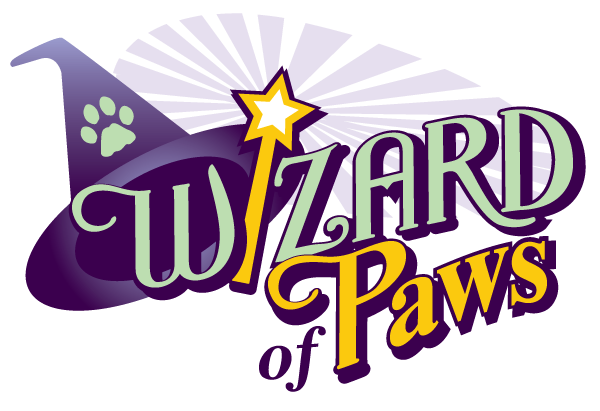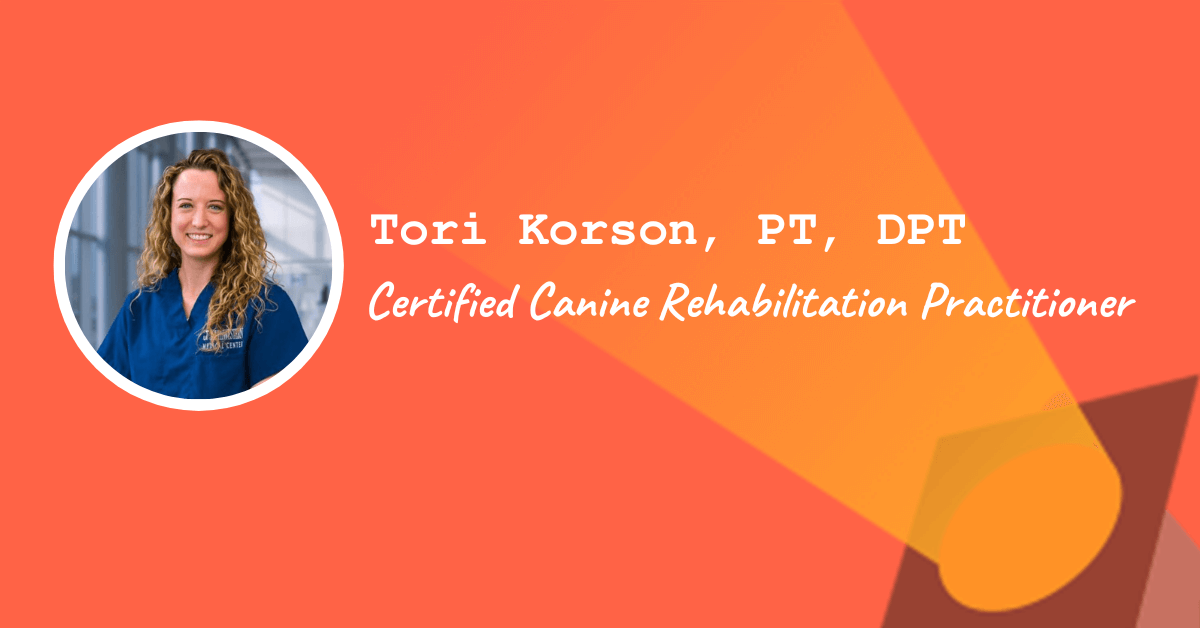Today’s spotlight is on Tori Korson, PT, DPT, who is a Certified Canine Rehabilitation Practitioner for Wizard of Paws!
This post may contain affiliate links or codes. This won’t increase your cost, but it helps keep TNCPT alive, and free of annoying ads! Thank you for your support. 🙂
What is your full name, title, and company name for your current, primary role?
Tori Korson, PT, DPT – Certified Canine Rehabilitation Practitioner for Wizard of Paws

Where are you located?
Colchester, CT
Where did you go to PT school, and what year did you graduate?
UT Southwestern Medical Center. I graduated in December of 2017.
What did you do when you first finished school, and for how long?
I worked in acute care at Clements University Hospital in Dallas, TX for about three years after graduating.
In what setting(s) did you work, and what types of patients did you treat?
I worked in a pretty diverse hospital, but for a while I was mostly seeing cardiopulmonary patients (CABG, heart/lung transplants, STEMI, etc.) I saw a wide range of ages but I mostly loved working with geriatric patients.
Please refrain from contacting our spotlight participants on social media. There are thousands of readers just like you out there. 🙂 Please ask your questions in the comments on this blog post.
If you’re a Non-Clinical 101 student, you can network with many of our spotlight participants in the alumni groups!
What did you enjoy about your early roles? What didn’t you enjoy?
Early on, I was just so happy to finally be working. I had dreamed of being a physical therapist for so long that it was surreal that I had finally made it.
Part of why I loved acute care was seeing the quick progress people made. Maybe the day after surgery they could only walk a couple of feet, but then three days later they’re walking laps around the unit. I also loved being able to make my own schedule.
I began feeling like I had to convince patients to let me do my job. When I first started working, I thought I was pretty good at turning refusals around. As I continued working, I began thinking, “Why am I spending all of this energy trying to convince a 55 year-old man to get out of bed to eat breakfast?” It just really began to drain all of my energy to the point where I just wasn’t happy any more.
When and why did you decide to do canine rehabilitation?
COVID played a big role in my decision to look for something else. I worked on the COVID floors through most of the pandemic, and it was tough. At first I was excited for something new and different, but it quickly turned into the same draining feeling I was having earlier.
I also feel that the pandemic changed a lot of patients’ mindsets. Many people refused therapy because they thought they knew what was best for their body, or they had read on the internet that they should stay in bed, etc. Don’t get me wrong–I had some wonderful patients while in acute care! However the refusals, anxiety, and overall setting really began to take a toll.
I always knew canine rehab was a thing, however I thought jobs would be next to impossible to get. I did some research and saw that there were a handful of openings in different states, and it was actually my husband that encouraged me to start taking the classes.
I started working on the modules for my CCRP (Certified Canine Rehabilitation Practitioner) through the University of Tennessee. I also observed at a canine rehab facility in Grapevine, TX and immediately fell in love with the setting.
What are you doing these days?
I just finished working at a specialty veterinary hospital in Houston, TX. I was fortunate enough to find a job that was willing to hire me while I was finishing up my CCRP certification. I worked under a board-certified Sports Medicine and Rehabilitation DVM and assisted with treatment plans and modalities for all of the dogs.
Due to my husband’s work, we will be moving to Connecticut where I will be working at Wizard of Paws. This smaller clinic is run by a physical therapist, so I am excited to see where it will take me!
Are you still treating patients, or are you solely non-clinical?
Still treating patients…just the canine variety!
How long have you been in canine rehab?
A little over a year.
Did you get any special certifications or training along the way to help you get into canine rehab?
There are two routes I could have taken:
- CCRP (Certified Canine Rehabilitation Practitioner) through University of Tennessee, or
- CCRT (Certified Canine Rehabilitation Therapist) through the Canine Rehabilitation Institute
I chose to go with CCRP because it allowed me to start the classes sooner (the first two modules are online), and it was slightly less expensive than the CCRT program.
Along with the two online modules, I traveled to North Carolina for a five-day in-person lecture and lab series. I then took a Canine Dry Needling elective course to complete my didactic work. Then, I worked through and documented five case studies that I followed through at least ten visits.
In August 2022, I sat for my written and practical exams to finish my certification.
How did you find your job? Did you apply or find it through a connection?
The University of Tennessee has a place where rehabilitation facilities can post job openings, and I saw there was a job opening in Houston that had been posted for about a month.
I honestly figured the spot would have been filled already, but I took a chance and applied anyways!
What was the interview like for the canine rehabilitation role?
I did a working interview, spending about half a day with the DVM and rehab assistant. This allowed me to get a feel of their team dynamics and see what kind of patients I would see in a typical day.
It was funny–as soon as I got there, I had to assist with a Saint Bernard that was so pooped from therapy that she just laid down in the middle of the hallway!
How have people reacted to you leaving patient care?
The most common reaction I got initially was, “Wait…dog PT? That’s a thing?”
Most of my friends and family members commented on how perfect the job sounded for me. I’ve always had a special bond with animals. If being a vet didn’t involve putting animals down or dealing with cancer diagnoses, I absolutely would have pursued that as a career.
I feel that this job gives me the best of both worlds: working with animals every day, while still using my PT knowledge!
What’s a typical day or week in the life like for you? What types of tasks and responsibilities fill your time?
At Gulf Coast, we would see anywhere from 10 to 24 patients in a day. There were three therapy technicians that assisted with the exercises and treadmill sessions.
My job was to oversee the technicians and make any adjustments to a dog’s treatment plan as I saw fit. For example, one of our patients was recently breezing her way through the Cavaletti rails (hurdles). I decided to challenge her a bit by placing some unstable surfaces in between each Cavaletti to enhance her balance and proprioception.
I was also in charge of seeing any hospital consults we received. Most consults were on post-op hemilaminectomy patients where I would perform early weight bearing exercises, laser, and create a home exercise program.
What are some of the rewards of your role? What are the biggest challenges?
I absolutely love hearing owners tell us how much better their pet is doing.
We get a lot of older dogs with osteoarthritis and a lot of the owners have been told something along the lines of “it is what it is.” No! We can do so much more for them!
I love watching the dog’s first walk on the treadmill when they realize so much weight is off of their joints. I also absolutely love cart fitting. There is nothing more satisfying than seeing a dog that can barely walk just start zooming around in a new set of wheels.
The biggest challenge I have is the reality of losing some of my patients. We saw a lot of older dogs pass away from cancer, and quite a few middle-aged dogs pass away from Degenerative Myelopathy (similar to ALS in humans). I think I was better at distancing myself from my human patients since I typically would only see them for a couple of days, a few weeks at most, before sending them on their way.
With these dogs I’m seeing them 2-3 times per week for at least a month. It’s very easy to create a special bond with these dogs, so it’s never easy to hear that one has passed.
How did your clinical background prepare you for this role? Which skills transferred?
Here’s something that I never knew before starting my classes: dogs have the same bones and muscles that we do!
It’s basically taking my human anatomy knowledge and thinking about it on someone on all fours. I would compare my new job to the outpatient ortho setting. We see a lot of tendinopathies, ligament tears, disc diseases, etc. I definitely had to review some of my ortho material!
Roughly speaking, how are the hours and pay compared to patient care?
I work 40 hours per week. I did take a pay cut compared to my acute care job, but it wasn’t anything super drastic. I was so miserable in my last job that the pay cut was completely worth it.
Also the best part…no weekends!
What type of person do you think would do well in your role?
Definitely an animal lover! It’s a whole different ballgame when your patient can’t tell you what they’re feeling. You also have to be in decent shape. I’m on the ground with these dogs for a large part of my day.
Do you work remotely or onsite?
Onsite
Did you read any books, take any courses, or do anything special overall to get you where you are today?
I referenced Canine Rehabilitation and Physical Therapy by Levine and Millis. It’s a great textbook if you’re ready to dive-in to this career path.
What is a typical career path for someone in your role?
It depends on your state’s practice act, but in some states PTs are allowed to work without the supervision of a DVM. I’ve seen a lot of posts on the Canine Physical Therapists Facebook page about PTs starting their own rehabilitation practice.
While that sounds enticing, I’m definitely grateful to be working under a DVM. There is so much I don’t know about canines that it’s good to have a mentor.
What is next for you?
I am excited for my new position at Wizard of Paws. I feel that I will have more freedom in my treatment programs since the clinic is owned by a physical therapist. The next certification I will pursue is the Certified Canine Manual Therapist (CCMT)–most of which is taught by my new boss!
What would you recommend to someone who is considering going into a canine rehabilitation role like yours?
If you have a dream, go for it!! If my husband hadn’t encouraged me to go for this role I never would have landed my absolute dream job.





